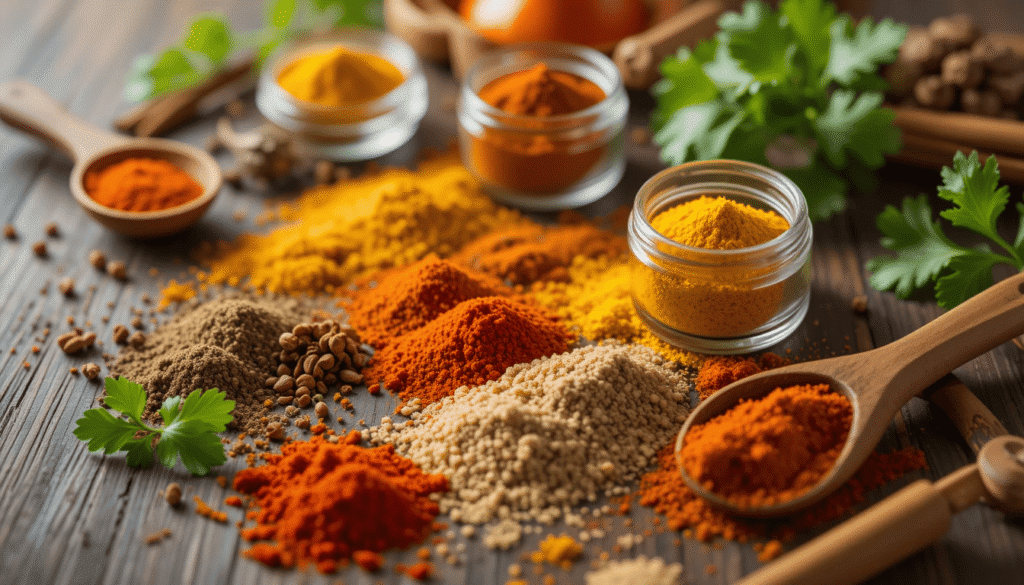Spices are more than just flavor enhancers; they are carriers of culture, history, and health. Whether it’s the warmth of cinnamon in a holiday dessert or the heat of chili powder in a spicy curry, spices have the power to elevate simple ingredients into extraordinary creations. This blog will take you on a flavorful journey, exploring the rich history of spices, their tremendous health benefits, how to use and store them effectively, and even some creative spice blends you can try at home. Ready to spice up your life?

Introduction to the world of spices and their significance
History and origin of popular spices
Health benefits of using spices in cooking
Guide to different types of spices and their uses
Tips for storing and using spices effectively
Creative spice blend recipes to try at home
Conclusion and call to action for readers to explore spices
A Brief History of Spices
The Global Roots of Spice Trading
Spices have played a significant role in human history, dating back thousands of years. The search for spices like pepper, cinnamon, and nutmeg fueled global exploration and shaped ancient trade routes. Civilizations like ancient Egypt used spices in rituals and cooking, while the Silk Road allowed the exchange of exotic seasonings between Asia, the Middle East, and Europe.
Popular Spice Origins
- Cinnamon: Native to Sri Lanka and southern India, cinnamon was once more valuable than gold. It gained prominence as early as 2000 BCE in Egypt.
- Black Pepper: Known as the “King of Spices,” black pepper originated in India and was so valuable in ancient Rome that it was used as currency.
- Nutmeg and Cloves: Indigenous to the Maluku Islands in Indonesia, these spices sparked the colonial spice wars of the 16th and 17th centuries.
- Turmeric: Indigenous to South Asia, turmeric has not only been used for cooking but also for its medicinal and ceremonial values in Indian culture.
Health Benefits of Spices
Many spices are backed by scientific evidence as being potent sources of antioxidants, anti-inflammatory properties, and essential nutrients. Here’s a breakdown of some health benefits you can gain by adding spices to your meals:
- Turmeric: Contains curcumin, which has been shown to reduce inflammation and act as a strong antioxidant. It may also improve brain function by boosting levels of BDNF (Brain-Derived Neurotrophic Factor).
- Cinnamon: Known to reduce blood sugar levels and aid in metabolism, cinnamon also has antibacterial and antifungal properties.
- Ginger: A go-to remedy for nausea, ginger is also powerful in reducing muscle pain and aiding digestion.
- Cardamom: Known as the “queen of spices,” cardamom aids digestion, lowers blood pressure, and fights bad breath.
- Black Pepper: Enhances nutrient absorption (especially turmeric’s curcumin) and aids in digestion.
A Guide to Different Types of Spices and How to Use Them
Sweet Spices
These spices are perfect for desserts and sweet beverages:
- Cinnamon: Great for baking, oatmeal, and warm drinks like chai or apple cider.
- Nutmeg: Adds depth to creamy dishes like custards, eggnog, or mashed sweet potatoes.
Savory Spices
These spices transform ordinary meals into unforgettable dishes:
- Cumin: Essential for curries, chili, and roasted vegetables.
- Paprika: A mild spice that can be smoky or sweet, perfect for stews, marinades, and rubs.
Hot and Spicy
Add some heat with these fiery options:
- Chili Powder: Ideal for tacos, stir-fries, and rubs for meats.
- Cayenne Pepper: Just a pinch can bring serious heat to sauces or dips.
Aromatic Spices
Bring out the best in lighter dishes or beverages:
- Cloves: Pair beautifully with baked goods or simmered in mulled wine.
- Cardamom: An essential in Indian desserts and Middle Eastern coffee.
Tips for Storing and Using Spices Effectively
To maximize the lifespan and potency of your spices, follow these tips:
- Store in a Cool, Dark Place: Heat, humidity, and light can degrade spices. Keep them in airtight containers away from the stove or windows.
- Grind Fresh When Possible: Whole spices retain their flavor longer. Grinding them just before use ensures maximum aroma and taste.
- Taste as You Go: Spices are powerful, and a little can go a long way. Start with small amounts and adjust to your preference.
- Label and Date Your Spices: Ground spices typically stay fresh for 1-2 years, while whole spices can last up to 4 years.
Creative Homemade Spice Blends
Why settle for store-bought when you can create custom spice blends tailored to your taste? Here are a few easy recipes to get started:
1. Classic Garam Masala
- 1 tbsp cumin
- 1 tbsp coriander
- 1 tbsp cardamom
- 1 tbsp black pepper
- 1 tsp cloves
- 1 tsp cinnamon
Toast the spices lightly in a pan before grinding to a powder. Use it in curries, soups, or marinades.
2. Smoky BBQ Rub
- 2 tbsp smoked paprika
- 1 tbsp brown sugar
- 1 tbsp garlic powder
- 1 tsp cumin
- 1 tsp cayenne pepper
Rub this mix over chicken, ribs, or tofu before grilling.
3. Mediterranean Herb Mix
- 1 tbsp oregano
- 1 tbsp thyme
- 1 tbsp basil
- 1 tsp rosemary
Use for seasoning roasted vegetables or meats, or sprinkle it over salads.
Time to Explore the World of Spices
Spices are far more than mere kitchen staples. They offer diversity, history, and health benefits in every pinch. Whether it’s crafting flavorful meals or creating your own custom blends, experimenting with spices is a gateway to new culinary adventures.
Take a moment this week to try a new recipe or add a twist to an old favorite. Once you experience the versatility that spices bring, you’ll wonder how you ever cooked without them.
Feeling inspired? Share your favorite spice blends or recipes in the comments. Happy cooking!
